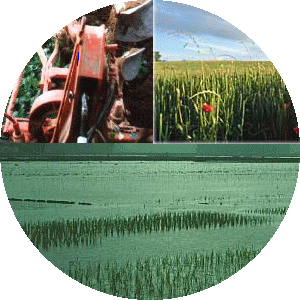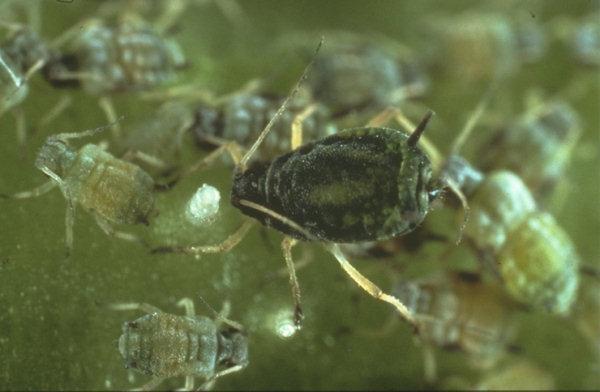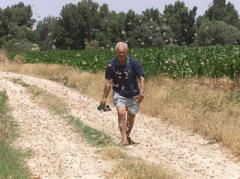 > ENC Master > Climate Encyclopaedia > Food & Climate > more > 1. Past and present > - diseases
> ENC Master > Climate Encyclopaedia > Food & Climate > more > 1. Past and present > - diseases
 |
|
|
|
|
Weeds, Diseases, and PestsClimate affects not just agricultural crops but their associated pests as well. The spatial and temporal distribution and proliferation of insects, weeds and disease causing agents is determined to a large extent by climate, because temperature, light, and water are major drivers for their growth and development.
|
|
Climate also affects the pesticides used to control or prevent pest outbreaks (i.e., the intensity and timing of rainfall influence pesticide persistence and efficiency; and temperature and light affect pesticide persistence though chemical alteration). Most analyses concur that in a changing climate, pests may become even more active than they are currently, expanding their geographical range, and may engender increased use of agricultural chemicals that carry health, ecological and economic costs.
|
|
Response to climate variablesBecause of the extremely large variation of pest species’ responses to meteorological conditions, it is difficult to draw overarching conclusions about the relationships between pests and weather. In general, however, most pest species are favoured by warm and humid conditions. But crop damages by pests are a consequence of the complex ecological dynamics between two or more organisms and therefore they are very difficult to predict; a weak crop during a drought is more likely to become infected than when it is not stressed. An example of this complexity could be the multi-coloured Asian lady beetle, native of Asia, that has adapted to climates and habitats in very different countries. On the one hand, it is a highly beneficial predator of insect pests, most of all aphids, but they can also create trouble when large numbers feed on fruit crops late in the season. Since lady beetles are a significant natural defence against aphids and other pests, it is important to correctly identify the Asian lady beetle and use restraint with pesticides or other management tactics. |
|
Precipitation – whether optimal, excessive, or insufficient – is probably the most important variable that affects crop-pest interactions. Both direct and indirect effects of moisture on crops make them more vulnerable and threaten damage by pests, especially in the early stages of plant development. Pest infestations often coincide with changes in climatic conditions, such as early or late rains, drought, or increases in humidity, which in themselves can reduce yields. In these circumstances, attributing specific losses to pests can be difficult. Table 1 shows key weather conditions that critically influence major pest epidemics and examples of resulting crop damages.
|
InsectsInsects flourish in all climates, their habitats and survival strategies are strongly dependent on local weather patterns, and are particularly sensitive to temperature because they are cold-blooded. Insects respond to higher temperature with increased rates of development. Warmer winters reduce winterkill, and consequently increase insect populations in subsequent growing seasons. Drought changes the physiology of those species from which insects feed (hosts species), and can reduce populations of friendly insects (like predators or parasitoids), spiders and birds, influencing the impact of pest infestations. Abnormally cool, wet conditions can also bring on severe insect and plant pathogen infestations, although excessive soil moisture may drown soil-residing insects. |
|
WeedsWeeds compete with crops for soil nutrients, light, and space. Drought conditions increase competition for soil moisture between crops and weeds, while humid conditions increase the proliferation of weeds. Warmer temperature regimes have been shown to increase the maximum biomass of grass weeds. Increased temperature and humidity result in the spread of diseases, as wet vegetation promotes the germination of spores and the proliferation of fungi and bacteria, and influences the lifecycle of soil nematodes. Some pathogens (e.g., powdery mildews) thrive in hot, dry conditions as long as there is dew formation at night. Most of the species classified as weeds are plants that can also be classified in the group of pioneer species, called like this due to their ability to adapt to a wide variety of environmental conditions and so being the first ones colonizing new spaces. This is why they become so dangerous some times, as they can survive in tougher conditions than many commercial species.
|
|
|
Recent Expansion of Weeds, Diseases, and PestsGlobal increases in pest-induced losses are observed in all regions and crops since the 1940s. During the same period, there was a huge increase in both the amount and toxicity of pesticide use. The increased pest damage arises form changes in production systems, enhanced resistance of some pests to pesticides, and the production of crops in warmer and more humid climatic regions where crops are more susceptible to pests. |
|
The ranges of several important insects, weeds, and pathogens have extended and expanded northwards. Recent climate trends and extreme weather events may be directly and indirectly contributing to the increased pest damage. Whether the change in global climate has contributed to these observations remains a research question. Even without climate change, pest management faces some serious challenges in the coming decades. The most striking of these are the increasingly high dependence on chemical treatments, and rising costs due to environmental protection and public health policies. Improved climate forecasts can help farmers prepare for changing seasonal-to-interannual conditions, and optimize pesticide management while minimizing environmental damage.
|
Author: Marta Moneo and Ana Iglesias- Universidad Politécnica de Madrid - España |



